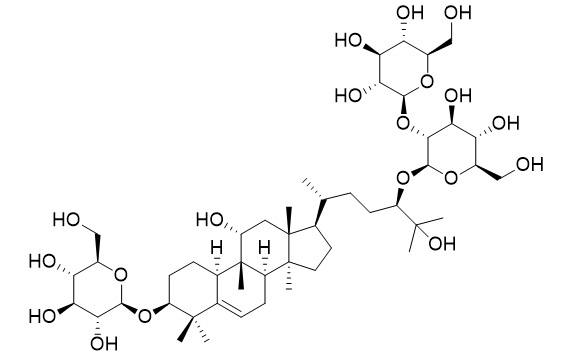Mogroside IIIe
Mogroside IIIe has anti-inflammatory activity, it attenuates LPS-induced acute lung injury in mice partly through regulation of the TLR4/MAPK/NF-κB axis via AMPK activation. It also has anti-fibrotic activity, it reduces pulmonary fibrosis through Toll-Like receptor 4 pathways.
Inquire / Order:
manager@chemfaces.com
Technical Inquiries:
service@chemfaces.com
Tel:
+86-27-84237783
Fax:
+86-27-84254680
Address:
1 Building, No. 83, CheCheng Rd., Wuhan Economic and Technological Development Zone, Wuhan, Hubei 430056, PRC
Providing storage is as stated on the product vial and the vial is kept tightly sealed, the product can be stored for up to
24 months(2-8C).
Wherever possible, you should prepare and use solutions on the same day. However, if you need to make up stock solutions in advance, we recommend that you store the solution as aliquots in tightly sealed vials at -20C. Generally, these will be useable for up to two weeks. Before use, and prior to opening the vial we recommend that you allow your product to equilibrate to room temperature for at least 1 hour.
Need more advice on solubility, usage and handling? Please email to: service@chemfaces.com
The packaging of the product may have turned upside down during transportation, resulting in the natural compounds adhering to the neck or cap of the vial. take the vial out of its packaging and gently shake to let the compounds fall to the bottom of the vial. for liquid products, centrifuge at 200-500 RPM to gather the liquid at the bottom of the vial. try to avoid loss or contamination during handling.
Molecules.2024, 29(11):2626.
Arch Toxicol.2024, 98(5):1415-1436.
Korean Journal of Pharmacognosy2018, 49(4):349-361
Cancer Sci.2022, 113(4):1406-1416.
Phytochemistry Letters2021, 43:80-87.
Sci Rep.2019, 9:19059
Mol Med Rep.2024, 29(2):26.
Int J Mol Sci.2015, 16(1):1232-51
Molecules.2019, 24(2):329
Phytochem Anal.2023, pca.3305.
Related and Featured Products
J Pharmacol Exp Ther. 2017 May;361(2):268-279.
Mogroside IIIE, a Novel Anti-Fibrotic Compound, Reduces Pulmonary Fibrosis through Toll-Like Receptor 4 Pathways.[Pubmed:
28280123 ]
Idiopathic pulmonary fibrosis is a progressive fibrotic lung disease, and eventually most patients develop respiratory failure with a median survival rate of 2 to 3 years after diagnosis due to the lack of clinically effective therapies.
Mogroside IIIe (MGIIIE), a cucurbitane-type compound, was isolated from Siraitia grosvenorii MGIIIE has shown the strongest inhibition of nitric oxide release, a crucial inflammatory factor, from lipopolysaccharide (LPS)-treated RAW264.7 cells compared with other mogrosides.
METHODS AND RESULTS:
In the pulmonary fibrosis mouse model induced by bleomycin,
MGIIIE treatment attenuated pulmonary fibrosis, indicated as a reduction in myeloperoxidase activity, collagen deposition, and pathologic score. MGIIIE also significantly suppressed expression of several important fibrotic markers, e.g., α-smooth muscle actin, collagen I, transforming growth factor-β (TGF-β) signal, and metalloproteinases-9/tissue inhibitor of metalloproteinase-1. Furthermore, MGIIIE blocked tansdifferentiation of lung resident fibroblasts into myofibroblast-like cells induced by TGF-β or LPS and subsequently inhibited collagen production in lung fibroblasts. These data indicate that MGIIIE is a potent inhibitor for pulmonary fibrosis. In vitro and in vivo mechanistic studies have shown that MGIIIE significantly decreased expression of toll-like receptor 4 (TLR4) and its downstream signals of myeloid differentiation factor 88 (MyD88)/mitogen-activated protein kinase (MAPK), an inflammatory signal essential for extracellular matrix (ECM) deposition in pulmonary fibroblasts.
CONCLUSIONS:
Taken together, these results demonstrate that MGIIIE significantly prevents pulmonary fibrosis by inhibiting pulmonary inflammation and ECM deposition through regulating TLR4/MyD88-MAPK signaling. Our study suggests that MGIIIE may have therapeutic potential for treating pulmonary fibrosis in clinical settings.
Phytother Res. 2017 Jul;31(7):1097-1106.
Mogroside IIIE Attenuates LPS-Induced Acute Lung Injury in Mice Partly Through Regulation of the TLR4/MAPK/NF-κB Axis via AMPK Activation.[Pubmed:
28512854]
Acute lung injury (ALI) often leads to high mortality, and there is as yet no effective drug treatment. The present study aimed to investigate protective effects of Mogroside IIIe (MGIIIE, a cucurbitane-type triterpenoid from Siraitia grosvenorii Fruits) in experimental ALI and its underlying mechanism.
METHODS AND RESULTS:
MGIIIE (1, 10 0r 20 mg/kg) was orally administered for 1 h before a single intratracheal administration of lipopolysaccharide (LPS, 5 mg/kg). MGIIIE treatment dose-dependently suppressed pulmonary oedema, pro-inflammatory mediators (IL-1β, IL-6, TNF-α and HMGB1) release and higher MPO activity in lung tissues induced by LPS challenge. Molecular researches showed that Mogroside IIIe (20 mg/kg) not only increased the phosphorylation of adenosine 5'-monophosphate-activated protein kinase (AMPK) but suppressed the over-expression of toll-like receptor 4 (TLR4) and myeloid differentiation factor 88 (MyD88). In addition, MGIIIE also inhibited the activation of MAPKs and nuclear factor κB (NF-κB) signalling in lung tissues from LPS-challenged mice. Similar antiinflammatory effects of MGIIIE were obtained in LPS-treated macrophages. Compound C (a pharmacological AMPK inhibitor) obviously reversed the antiinflammatory effect of MGIIIE in LPS-induced ALI mice.
CONCLUSIONS:
Taken together, AMPK activation plays a crucial role in the antiinflammatory effects of MGIIIE in LPS-induced ALI by down-regulating TLR4/MAPK/NF-κB signalling pathways.



